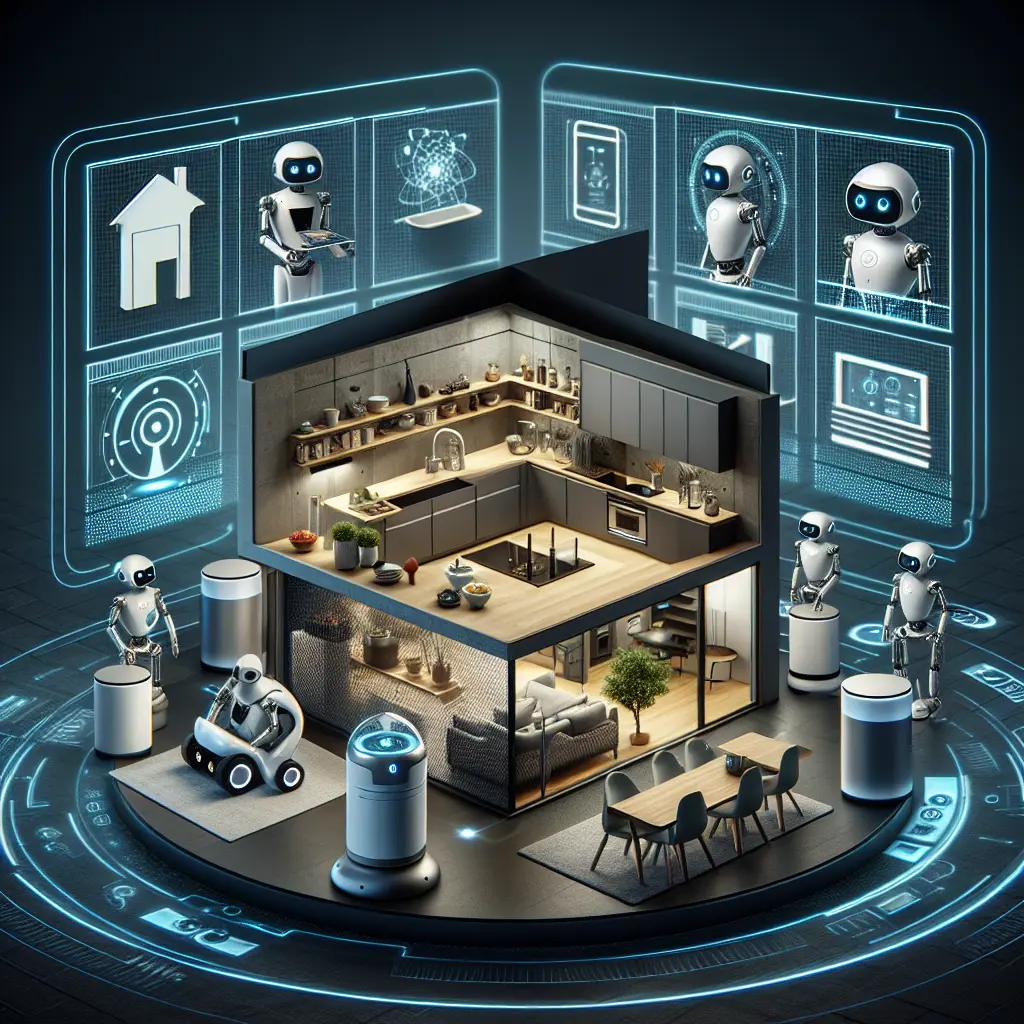
Introduction
In the rapidly evolving landscape of home automation systems, robotics is at the forefront of a transformative revolution. This movement is not merely a trend but a powerful shift redefining intelligent home systems and advancing automated home solutions. As homes become smarter, robotic home assistants are becoming increasingly ubiquitous, offering seamless integration into everyday life and transforming our interaction with living spaces.
Robotics in home automation is reshaping our future living experiences, promising more than just convenience. It enhances security, efficiency, and sustainability through cutting-edge advancements in AI. The integration of sophisticated robotics with home automation devices creates intuitive and responsive environments tailored to individual needs. These intelligent systems are setting new benchmarks for what smart home technology can achieve.
As we explore the future of home automation, we witness an era where robotics integration transcends basic automation tasks, evolving into comprehensive solutions that anticipate and respond to the needs of their inhabitants. The synergy between robotics and smart homes crafts a future where our living environments are more intelligent, adaptable, and interconnected than ever before. Let's delve deeper into this exciting domain and uncover the myriad possibilities in robotics within domestic settings.
The landscape of home automation systems is undergoing a dramatic transformation with the advent of robotics technology. This revolution is characterized not only by enhanced convenience but also by profound changes in our interaction with living spaces. Robotic home assistants and automated solutions redefine daily experiences. Let’s explore how robotics is revolutionizing home automation systems through recent developments and insights.
The Integration of Robotics in Home Automation
Robotics technology seamlessly integrates into home automation systems, offering intelligent home systems that are responsive, adaptive, and tailored to individual needs. With the increasing presence of AI, homes can think and respond almost autonomously.
Robotic home assistants have moved beyond futuristic concepts to become integral parts of modern living, helping manage household tasks, enhance security, and increase efficiency. Devices like robotic vacuum cleaners and lawn mowers are practical applications of robotics for smart living.
Recent Advancements in Robotics Technology
Recent developments have propelled the robotics revolution in homes further. For instance, PepsiCo's use of robotics, satellites, and sensors to optimize its supply chain illustrates the potential of robotics technology to enhance efficiency within homes.
Moreover, Taco Bell's incorporation of AI in drive-thrus highlights the rapid deployment of AI technologies in everyday settings. These advancements underscore the potential for similar AI-driven systems in home automation devices, offering smarter solutions for daily tasks.
Enhancing Security and Sustainability
Robotics in home automation promises enhanced security and sustainability. Intelligent surveillance systems equipped with AI monitor homes more effectively than traditional methods, ensuring safety and peace of mind for homeowners. These systems offer a proactive approach to security by responding to specific triggers.
On the sustainability front, robotics technology aids in optimizing energy usage. Smart thermostats and lighting systems adjust based on occupancy and preferences, reducing energy waste and lowering utility bills. This aligns with broader goals to create sustainable living environments contributing to global climate change efforts.
Overcoming Adoption Barriers
Despite clear benefits, some small-to-midsize manufacturers (SMM) hesitate to adopt advanced automation platforms. However, as these technologies become more accessible and cost-effective, there is a growing trend towards embracing Industry 4.0. Overcoming hesitancy is crucial for widespread adoption in domestic settings.
Case Study: Covariant's AI Software
A notable development is Amazon's interest in acquiring Covariant, a company specializing in AI software for industrial robots. This move signals the increasing importance of advanced AI solutions for automating tasks not only in industrial settings but potentially within homes. Covariant's technology could lead to more sophisticated robotics integration at home.
Robotics and Smart Home Innovation: Current Trends
Current trends in smart home robotics indicate a continuous drive towards personalized and efficient living spaces. For example, robots in Shake Shack demonstrate how robotics can enhance service delivery, providing insights into potential adaptations for home use, such as robots assisting with cooking or cleaning.
Investment in AI-driven home automation systems underscores the focus on creating intelligent environments. The synergy between robotics and smart homes is crafting a future where our living environments are interconnected like never before.
Future Outlook: What Lies Ahead?
Looking to the future, the role of robotics will continue to expand as ongoing advancements in AI and machine learning enable home automation systems to become even more intuitive. This evolution will result in homes anticipating the needs of their inhabitants and adjusting accordingly.
As consumer expectations evolve, there will be an emphasis on developing user-friendly interfaces and ensuring seamless integration with existing smart home technology. The goal is to create intelligent environments that enhance residents' quality of life.
Conclusion: Embracing the Future of Robotics in Home Automation
The integration of robotics in home automation is undeniably reshaping how we live and interact with our surroundings. Here's a recap of key points discussed:
- Seamless Integration: Robotics technology is deeply embedded in home automation systems, resulting in intelligent environments catering to individual needs.
- Practical Applications: Robotic assistants manage household tasks, enhance security, and increase efficiency.
- Recent Advancements: Rapid AI deployment showcases potential for similar systems in homes.
- Security and Sustainability: Robotics enhance security through intelligent surveillance and promote sustainability by optimizing energy usage.
- Adoption Challenges: Overcoming hesitancy from manufacturers is crucial for broader adoption.
- Future Outlook: As AI advances, home systems will become more intuitive, enhancing life quality.
In this evolving landscape, your role as a consumer is vital. Embrace this transformation by exploring innovative robotic solutions for your home. Share your experiences and insights on how these technologies have impacted your daily life. Your feedback can inspire others and drive further advancements in this exciting field.
Thank you for joining me on this journey into the future of robotics in home automation. Let's continue to innovate and create smarter, safer, and more sustainable living environments together.
Author: Nora Pennington